Nanoscale Characterization of V-Defect in InGaN/GaN QWs LEDs Using Near-Field Scanning Optical Microscopy
Abstract
:1. Introduction
2. Materials and Methods
2.1. Epitaxial Growth and Chip Fabrication
2.2. Characterization
3. Results
4. Conclusions
Author Contributions
Funding
Conflicts of Interest
References
- Laubsch, A.; Sabathil, M.; Baur, J.; Peter, M.; Hahn, B. High-Power and High-Efficiency InGaN-Based Light Emitters. IEEE Trans. Electron Dev. 2010, 57, 79–87. [Google Scholar] [CrossRef]
- Verzellesi, G.; Saguatti, D.; Meneghini, M.; Bertazzi, F.; Goano, M.; Meneghesso, G.; Zanoni, E. Efficiency droop in InGaN/GaN blue light-emitting diodes: Physical mechanisms and remedies. J. Appl. Phys. 2013, 114, 071101. [Google Scholar] [CrossRef]
- Zhao, Y.; Fu, H.; Wang, G.; Nakamura, S. Toward ultimate efficiency: Progress and prospects on planar and 3D nanostructured nonpolar and semipolar InGaN light-emitting diodes. Adv. Opt. Photonics 2018, 10, 246–308. [Google Scholar] [CrossRef]
- Kim, J.; Kim, J.; Tak, Y.; Chae, S.; Kim, Y.; Park, Y. Effect of V-shaped pit size on the reverse leakage current of InGaN/GaN light-emitting diodes. IEEE Electron Dev. Lett. 2013, 34, 1409–1411. [Google Scholar] [CrossRef]
- Yang, J.; Zhao, D.; Jiang, D.; Liu, S.; Chen, P.; Zhu, J.; Liang, F.; Liu, W.; Li, M. Improvement of thermal stability of InGaN/GaN multiple-quantum-well by reducing the density of threading dislocations. Opt. Mater. 2018, 85, 14–17. [Google Scholar] [CrossRef]
- Hangleiter, A.; Hitzel, F.; Netzel, C.; Fuhrmann, D.; Rossow, U.; Ade, G.; Hinze, P. Suppression of Nonradiative Recombination by V-Shaped Pits in GaInN/GaN Quantum Wells Produces a Large Increase in the Light Emission Efficiency. Phys. Rev. Lett. 2005, 95, 127402. [Google Scholar] [CrossRef]
- Tomiya, S.; Kanitani, Y.; Tanaka, S.; Ohkubo, T.; Hono, K. Atomic scale characterization of GaInN/GaN multiple quantum wells in V-shaped pits. Appl. Phys. Lett. 2011, 98, 181904. [Google Scholar] [CrossRef]
- Koike, K.; Lee, S.; Cho, R.; Park, J.; Lee, H.; Ha, J.; Hong, S.; Lee, H.; Cho, M.; Yao, T. Improvement of Light Extraction Efficiency and Reduction of Leakage Current in GaN-Based LED via V-Pit Formation. IEEE Photon. Technol. Lett. 2012, 24, 449–451. [Google Scholar] [CrossRef]
- Han, H.; Lee, Y.; Shim, W.; Lee, W.; Kim, J.; Yoon, S.; Kim, S.; Kim, T. Improvement of efficiency and electrical properties using intentionally formed V-shaped pits in InGaN/GaN multiple quantum well light-emitting diodes. Appl. Phys. Lett. 2013, 102, 251123. [Google Scholar] [CrossRef]
- Sheen, M.; Kim, S.; Lee, J.; Shim, J.; Kim, Y. V-pits as Barriers to Diffusion of Carriers in InGaN/GaN Quantum Wells. J. Electron. Mater. 2015, 44, 11. [Google Scholar] [CrossRef]
- Liu, M.; Zhao, J.; Zhou, S.; Gao, Y.; Hu, J.; Liu, X.; Ding, X. An InGaN/GaN Superlattice to Enhance the Performance of Green LEDs: Exploring the Role of V-Pits. Nanomaterials 2018, 8, 450. [Google Scholar] [CrossRef]
- Kim, J.; Cho, Y.; Ko, D.; Li, S.; Won, Y.; Lee, E.; Park, S.; Kim, J.; Kim, S. Influence of V-pits on the efficiency droop in InGaN/GaN quantum wells. Opt. Express 2014, 22, A857–A866. [Google Scholar] [CrossRef] [PubMed]
- Wu, X.; Liu, J.; Jiang, F. Hole injection from the sidewall of V-shaped pits into c-plane multiple quantum wells in InGaN light emitting diodes. J. Appl. Phys. 2015, 118, 164504. [Google Scholar] [CrossRef]
- Wu, X.; Liu, J.; Quan, Z.; Xiong, C.; Zheng, C.; Zhang, J.; Mao, Q.; Jiang, F. Electroluminescence from the sidewall quantum wells in the V-shaped pits of InGaN light emitting diodes. Appl. Phys. Lett. 2014, 104, 221101. [Google Scholar] [CrossRef]
- Han, D.; Ma, S.; Jia, Z.; Jia, W.; Liu, P.; Dong, H.; Shang, L.; Zhang, A.; Zhai, G.; Li, X.; et al. Photoluminescence close to V-shaped pits in the quantum wells and enhanced output power for InGaN light emitting diode. J. Phys. D Appl. Phys. 2017, 50, 475103. [Google Scholar] [CrossRef]
- Quan, Z.; Wang, L.; Zheng, C.; Liu, J.; Jiang, F. Roles of V-shaped pits on the improvement of quantum efficiency in InGaN/GaN multiple quantum well light-emitting diodes. J. Appl. Phys. 2014, 116, 183107. [Google Scholar]
- Meng, X.; Wang, L.; Hao, Z.; Luo, Y.; Sun, C.; Han, Y.; Xiong, B.; Wang, J.; Li, H. Study on efficiency droop in InGaN/GaN light-emitting diodes based on differential carrier lifetime analysis. Appl. Phys. Lett. 2016, 108, 013501. [Google Scholar] [CrossRef]
- Kaneta, A.; Kim, Y.; Funato, M.; Kawakami, Y.; Enya, Y.; Kyono, T.; Ueno, M.; Nakamura, T. Nanoscopic photoluminescence properties of a green-emitting InGaN single quantum well on a (2021) GaN substrate probed by scanning near-field optical microscopy. Appl. Phys. Express 2012, 5, 102104. [Google Scholar] [CrossRef]
- Liu, J.T.; Perkins, N.R.; Horton, M.N.; Redwing, J.M.; Tischler, M.A.; Kuech, T.F. A nearfield scanning optical microscopy study of the photoluminescence from GaN films. Appl. Phys. Lett. 1996, 69, 3519–3521. [Google Scholar] [CrossRef]
- Kim, J.; Samiee, K.; Jeffrey, O.W.; Myoung, J.M.; Kim, K. Near-field photoluminescence spectroscopy of InGaN films grown by molecular-beam epitaxy. Appl. Phys. Lett. 2002, 80, 989–991. [Google Scholar] [CrossRef]
- Marcinkevičius, S.; Zhao, Y.; Kelchner, K.M.; Nakamura, S.; DenBaars, S.P.; Speck, J.S. Near-field investigation of spatial variations of (2021) InGaN quantum well emission spectra. Appl. Phys. Lett. 2013, 103, 131116. [Google Scholar] [CrossRef]
- Okada, N.; Kashihara, H.; Sugimoto, K.; Yamada, Y.; Tadatomo, K. Controlling potential barrier height by changing V-shaped pit size and the effect on optical and electrical properties for InGaN/ GaN based light-emitting diodes. J. Appl. Phys. 2015, 117, 025708. [Google Scholar] [CrossRef]
- Hitzel, F.; Klewer, G.; Lahmann, S.; Rossow, U.; Hangleiter, A. Localized high-energy emissions from the vicinity of defects in high-efficiency GaxIn1-xN/GaN quantum wells. Phys. Rev. B 2005, 72, 081309R. [Google Scholar] [CrossRef]
- Kaneta, A.; Funato, M.; Kawakami, Y. Nanoscopic recombination processes in InGaN/GaN quantum wells emitting violet, blue, and green spectra. Phys. Rev. B 2008, 78, 125317. [Google Scholar] [CrossRef]
- Kawakami, Y.; Kaneta, A.; Hashiya, A.; Funato, M. Impact of Radiative and Nonradiative Recombination Processes on the Efficiency-Droop Phenomenon in InxGa1−xN Single Quantum Wells Studied by Scanning Near-Field Optical Microscopy. Phys. Rev. Appl. 2016, 6, 044018. [Google Scholar] [CrossRef]
- Kurai, S.; Higaki, S.; Imura, N.; Okawa, K.; Makio, R.; Okada, N.; Tadatomo, K.; Yamada, Y. Potential Barrier Formed Around Dislocations in InGaN Quantum Well Structures by Spot Cathodoluminescence Measurements. Phys. Status Solidi B 2018, 255, 1700358. [Google Scholar] [CrossRef]
- Gardner, N.; Müller, G.; Shen, Y.; Chen, G.; Watanabe, S.; Götz, W.; Krames, R. Blue-emitting InGaN–GaN double-heterostructure light-emitting diodes reaching maximum quantum efficiency above 200 A/cm2. Appl. Phys. Lett. 2007, 91, 243506. [Google Scholar] [CrossRef]
- Shen, Y.; Mueller, G.; Watanabe, S.; Gardner, N.; Munkholm, A.; Krames, M. Auger recombination in InGaN measured by photoluminescence. Appl. Phys. Lett. 2007, 91, 141101. [Google Scholar] [CrossRef]
- Jongin, S.; Hyungsung, K.; Dongsoo, S.; Hanyoul, Y. An Explanation of Efficiency Droop in InGaN-based Light Emitting Diodes: Saturated Radiative Recombination Rate at Randomly Distributed In-Rich Active Areas. J. Korean Phys. Soc. 2011, 58, 503–508. [Google Scholar]
- Meyaard, D.; Lin, G.; Shan, Q.; Cho, J.; Schubert, F.; Shim, H.; Kim, M.; Sone, C. Asymmetry of carrier transport leading to efficiency droop in GaInN based light-emitting diodes. Appl. Phys. Lett. 2011, 99, 251115. [Google Scholar] [CrossRef]
- Chang, C.; Li, H.; Shih, Y.; Lu, T. Manipulation of nanoscale V-pits to optimize internal quantum efficiency of InGaN multiple quantum wells. Appl. Phys. Lett. 2015, 106, 091104. [Google Scholar] [CrossRef]
- Watanabe, K.; Yang, J.; Huang, S.; Inoke, K.; Hsu, J.; Tu, R.; Yamazaki, T.; Nakanishi, N.; Shiojiri, M. Formation and structure of inverted hexagonal pyramid defects in multiple quantum wells InGaN/GaN. Appl. Phys. Lett. 2003, 82, 718. [Google Scholar] [CrossRef]
- Shiojiri, M.; Chuo, C.; Hsu, J.; Yang, T.; Saijo, H. Structure and formation mechanism of V defects in multiple InGaN/GaN quantum well layers. J. Appl. Phys. 2006, 99, 073505. [Google Scholar] [CrossRef]
- Jeong, M.S.; Kim, J.Y.; Kim, Y.-W.; White, J.O.; Suh, E.-K.; Hong, C.-H.; Lee, H.J. Spatially resolved photoluminescence in InGaN/GaN quantum wells by near-field scanning optical microscopy. Appl. Phys. Lett. 2001, 79, 976–978. [Google Scholar] [CrossRef]
- Kanetal, A.; Izumt, T.; Okamoto, K.; Kawakami, Y.; Fujita, S.; Narita, Y.; Inoue, T.; Mukai, T. Spatial inhomogeneity of photoluminescence in an InGaN-based lightemitting diode structure probed by near-field optical microscopy under illumination-collection mode. Jpn. J. Appl. Phys. 2001, 40, 110–111. [Google Scholar] [CrossRef]
- Marcinkevicˇius, S.; Jain, R.; Shatalov, M.; Yang, J.; Shur, M.; Gaska, R. High spectral uniformity of AlGaN with a high Al content evidenced by scanning near-field photoluminescence spectroscopy. Appl. Phys. Lett. 2014, 105, 241108. [Google Scholar] [CrossRef]
- Greco, G.; Iucolano, F.; Bongiorno, C.; Giannazzo, F.; Krysko, M.; Leszczynski, M.; Roccaforte, F. Ti/Al ohmic contacts on AlGaN/GaN heterostructures with different defect density. Appl. Surf. Sci. 2014, 314, 546–551. [Google Scholar] [CrossRef]
- Ryu, Y.; Jeon, S.; Kang, M.; Yuh, H.; Choi, Y.; Lee, J. A comparative study of efficiency droop and internal electric field for InGaN blue lighting-emitting diodes on silicon and sapphire substrates. Sci. Rep. 2017, 7, 44814. [Google Scholar] [CrossRef] [PubMed]
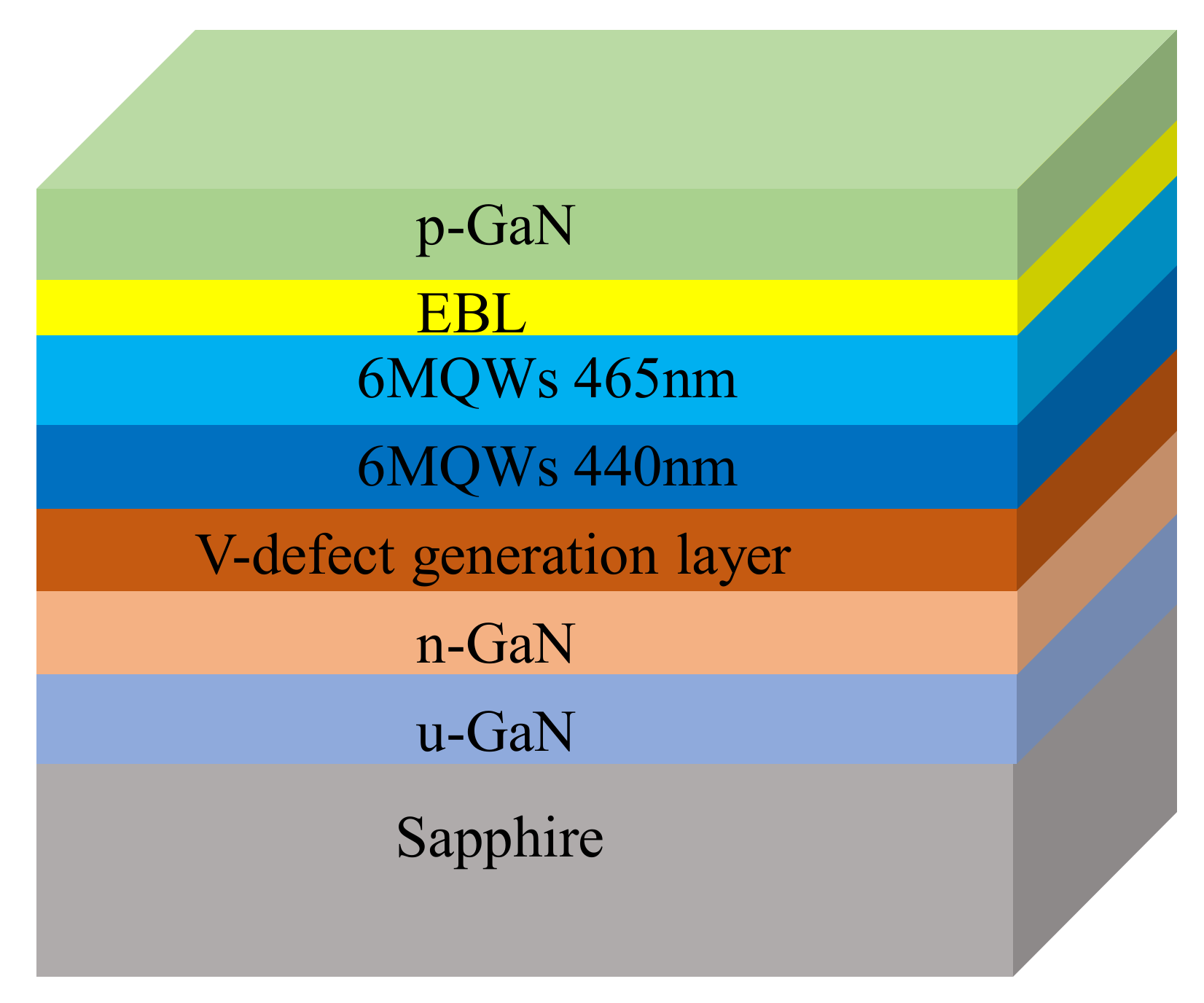
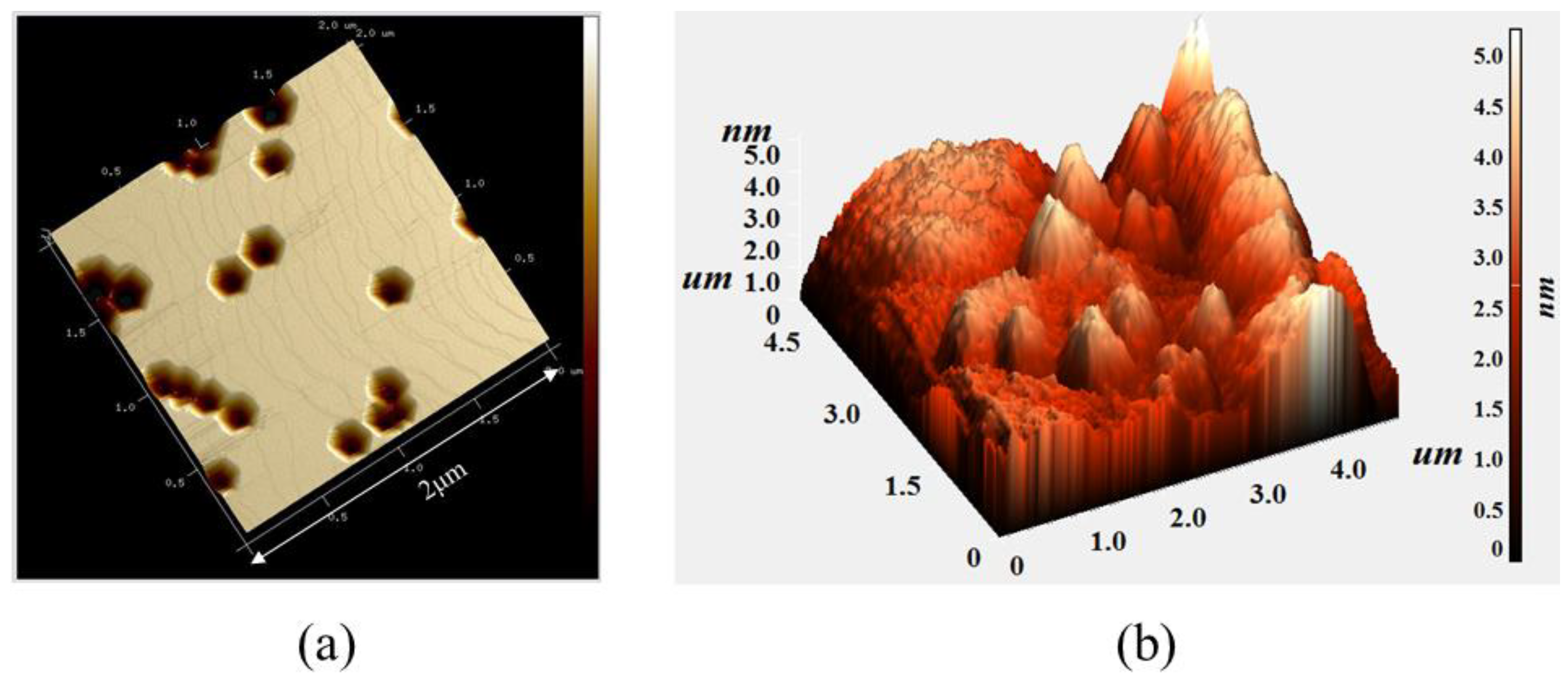
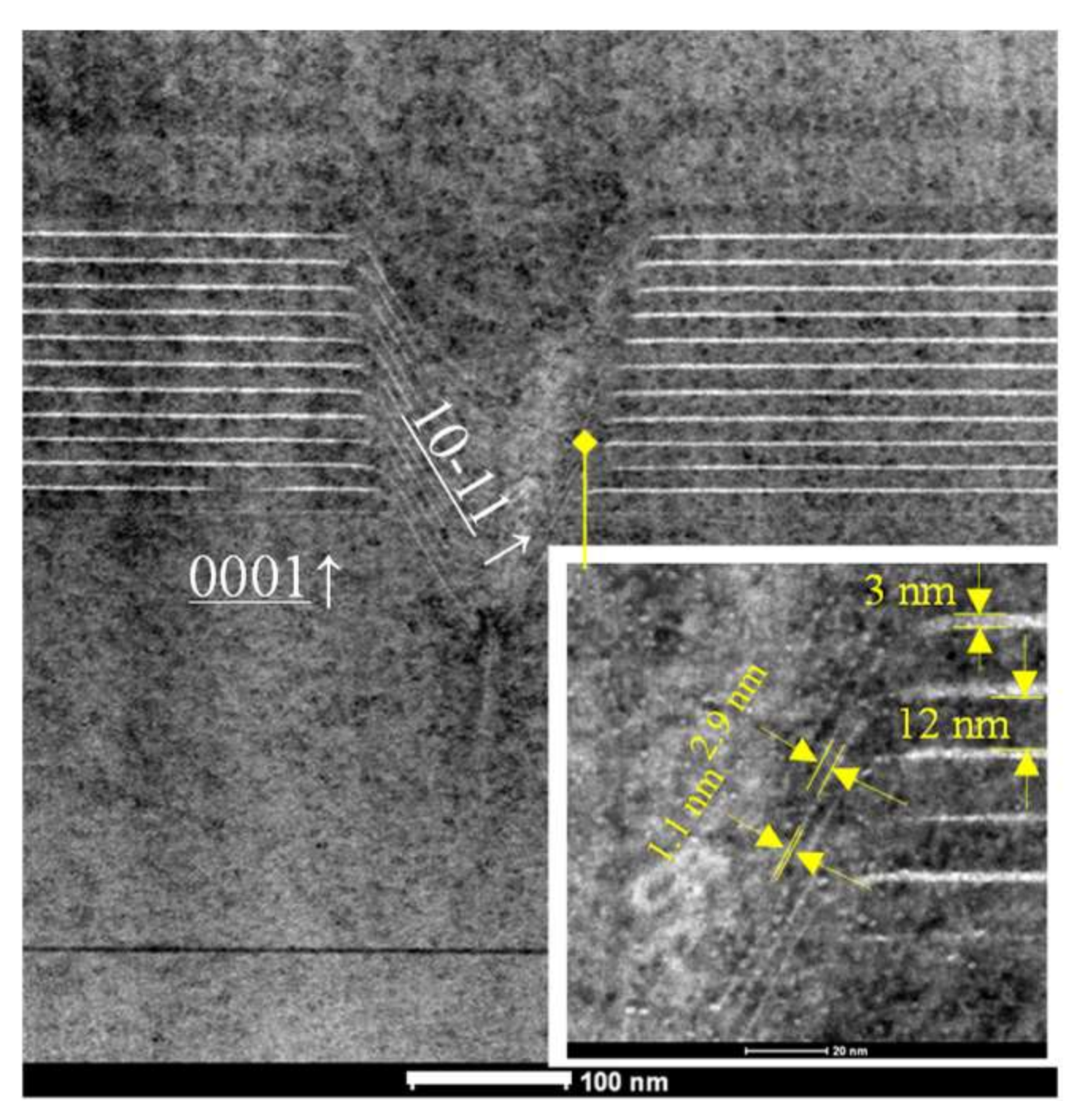
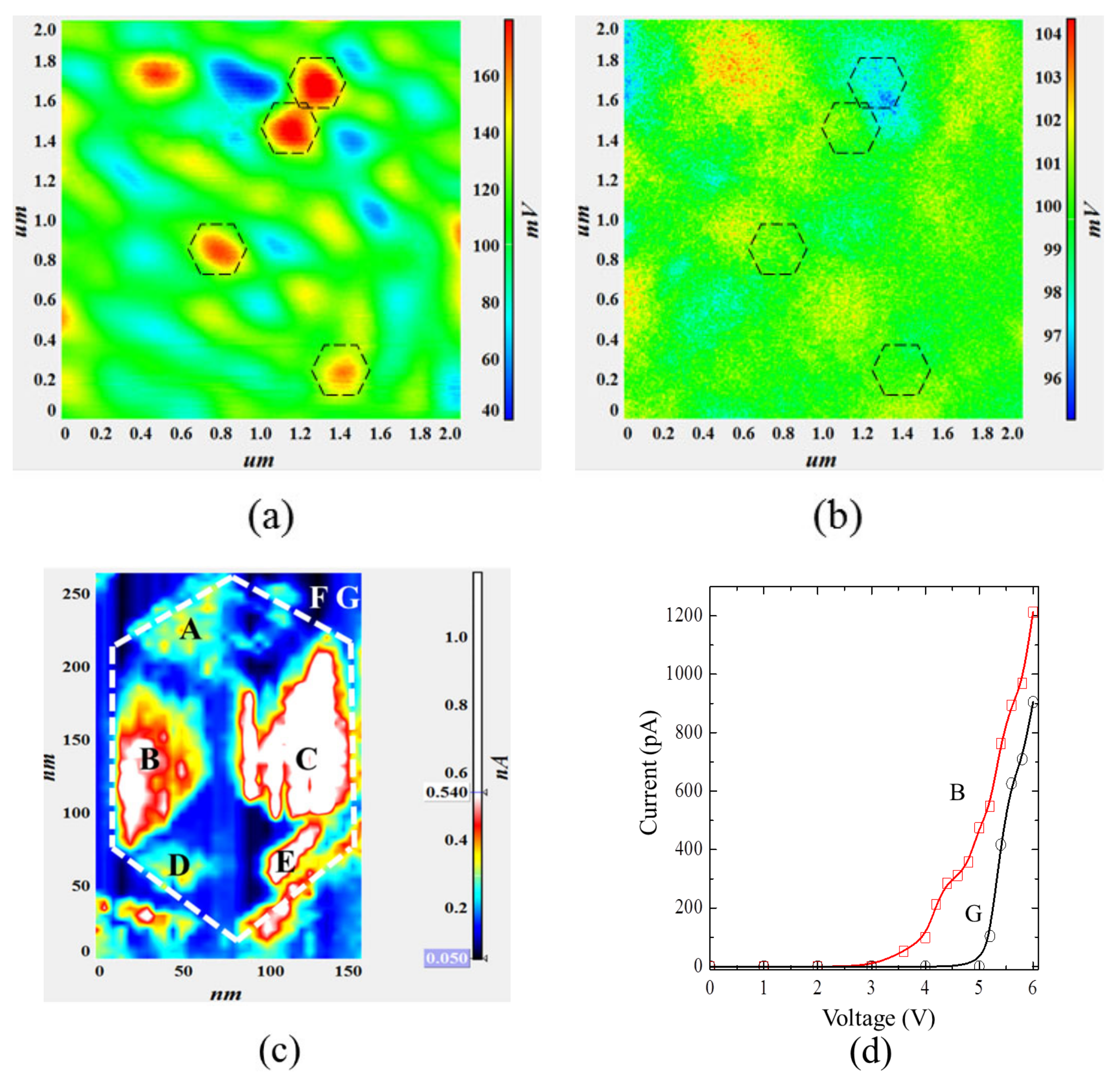

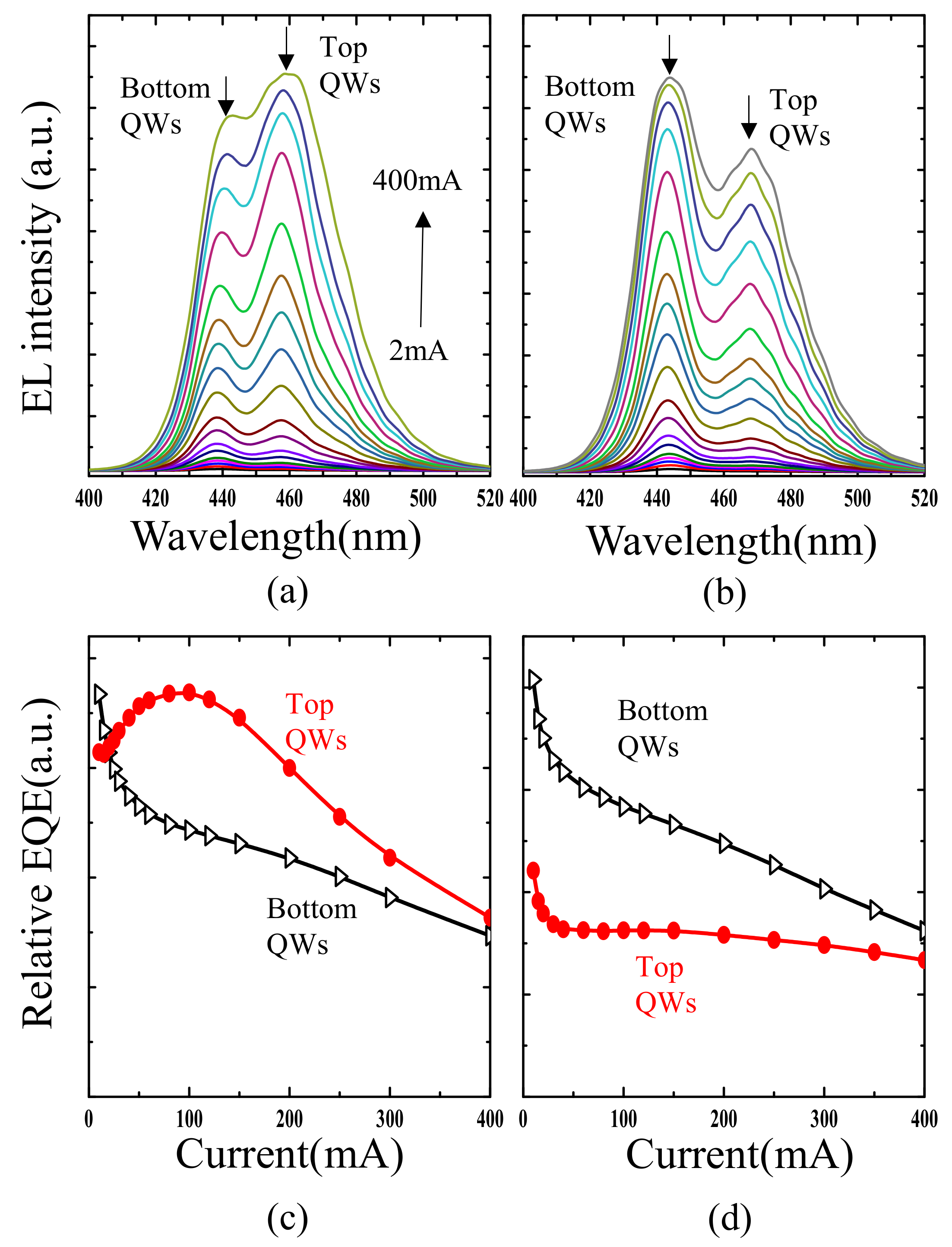
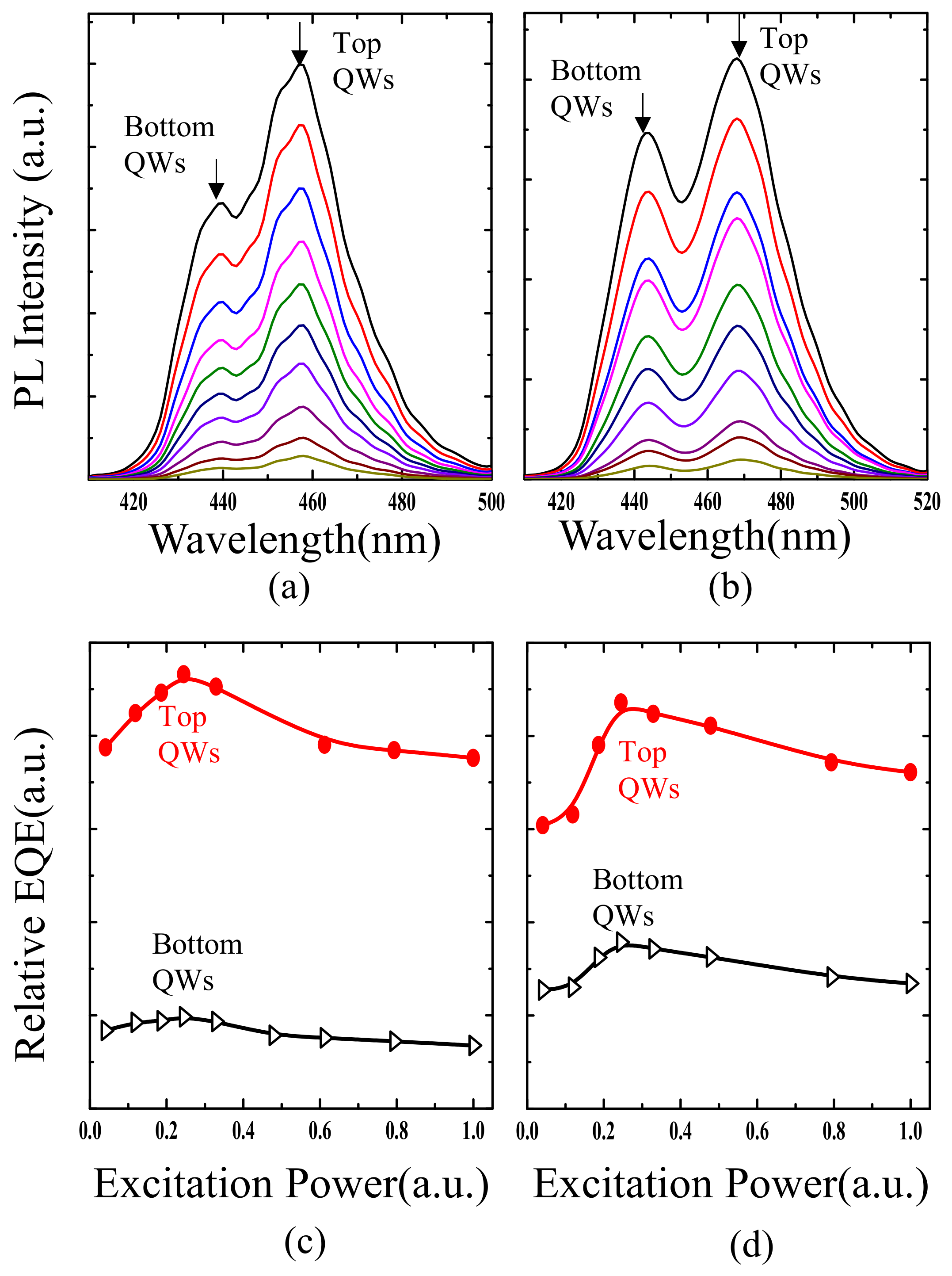

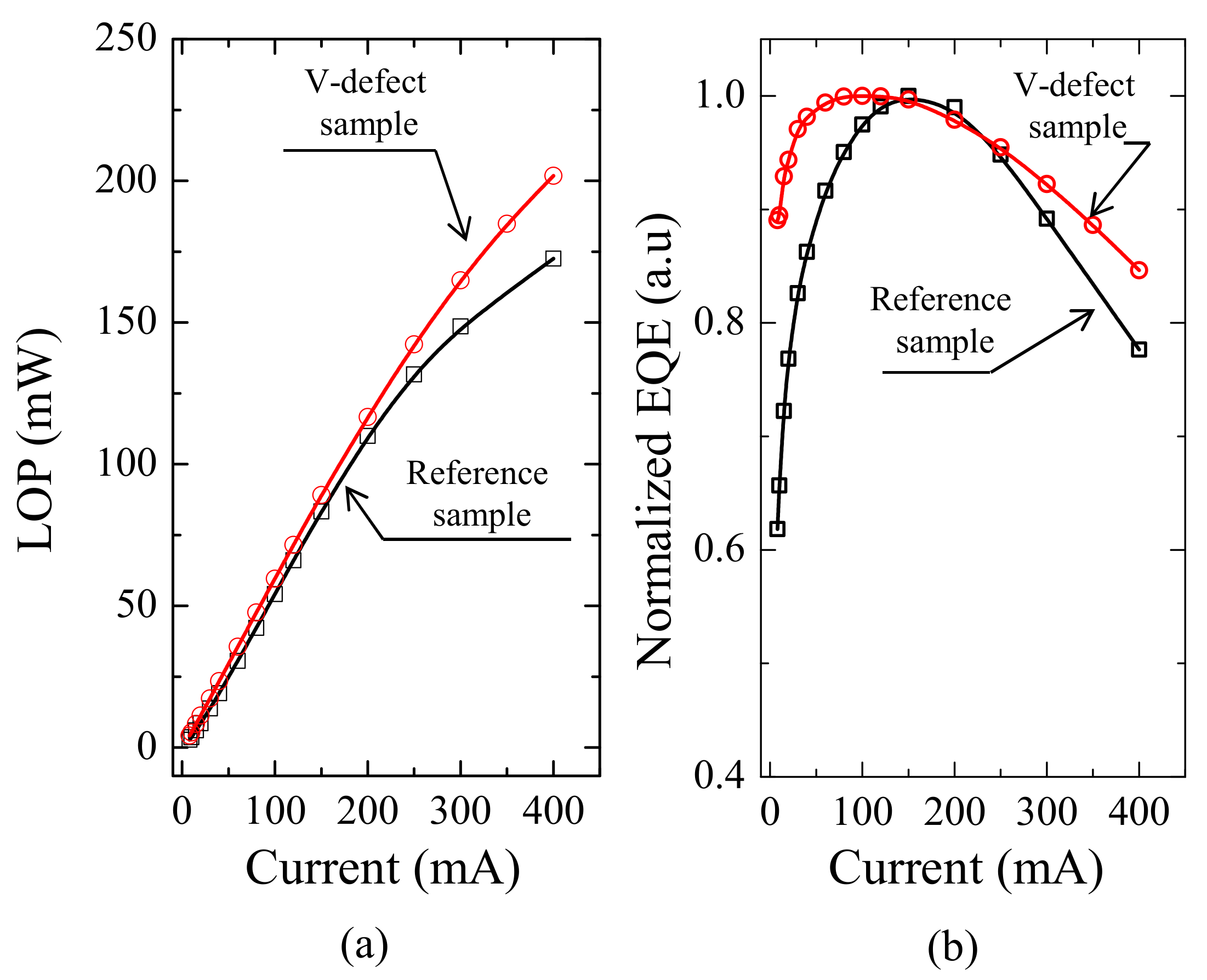
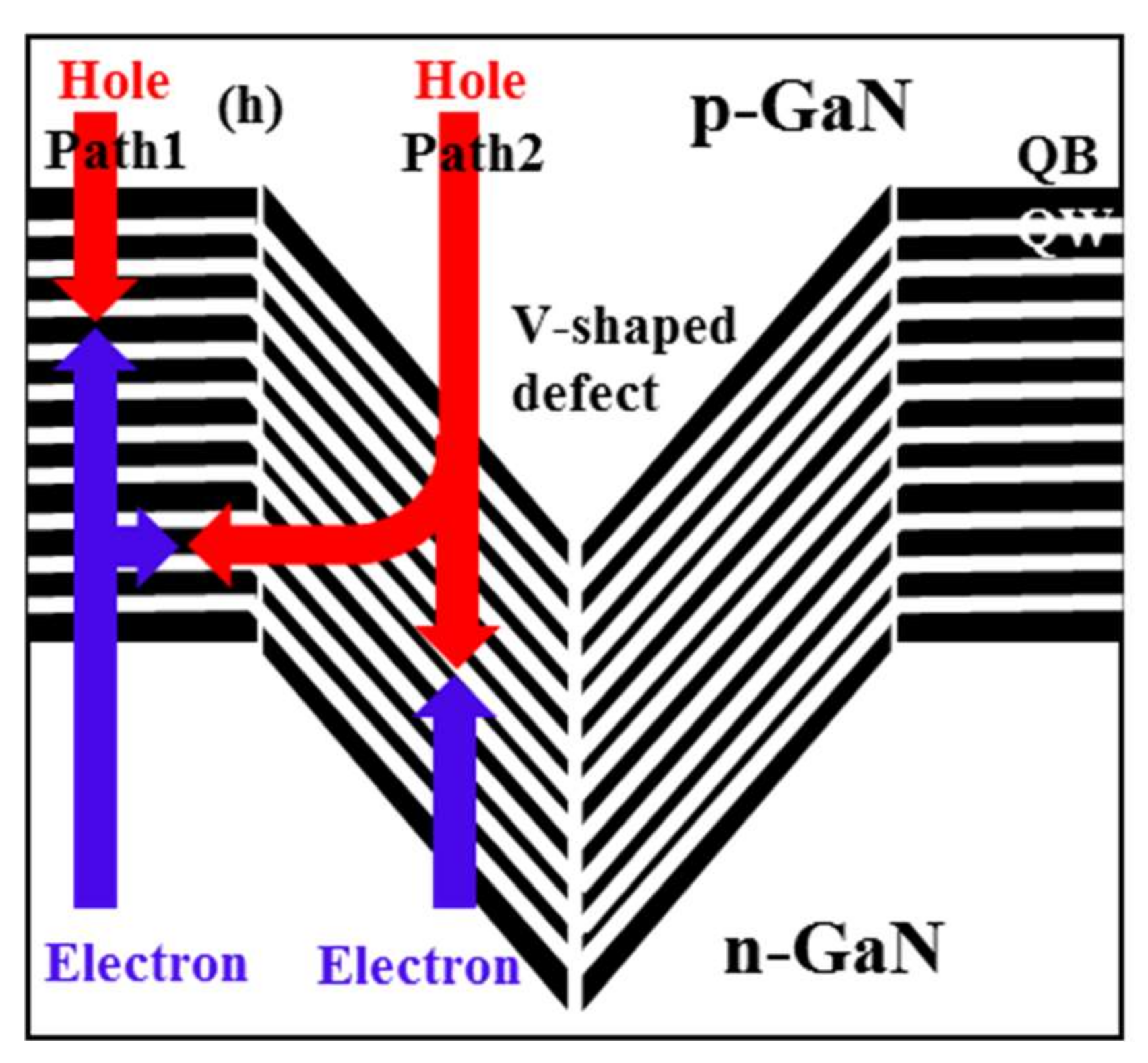
| Sample | IQE of Bottom QWs | IQE of Top QWs |
|---|---|---|
| Reference | 0.240 | 0.532 |
| Large V-defects | 0.312 | 0.410 |
© 2019 by the authors. Licensee MDPI, Basel, Switzerland. This article is an open access article distributed under the terms and conditions of the Creative Commons Attribution (CC BY) license (http://creativecommons.org/licenses/by/4.0/).
Share and Cite
Li, Y.; Tang, W.; Zhang, Y.; Guo, M.; Li, Q.; Su, X.; Li, A.; Yun, F. Nanoscale Characterization of V-Defect in InGaN/GaN QWs LEDs Using Near-Field Scanning Optical Microscopy. Nanomaterials 2019, 9, 633. https://doi.org/10.3390/nano9040633
Li Y, Tang W, Zhang Y, Guo M, Li Q, Su X, Li A, Yun F. Nanoscale Characterization of V-Defect in InGaN/GaN QWs LEDs Using Near-Field Scanning Optical Microscopy. Nanomaterials. 2019; 9(4):633. https://doi.org/10.3390/nano9040633
Chicago/Turabian StyleLi, Yufeng, Weihan Tang, Ye Zhang, Maofeng Guo, Qiang Li, Xilin Su, Aixing Li, and Feng Yun. 2019. "Nanoscale Characterization of V-Defect in InGaN/GaN QWs LEDs Using Near-Field Scanning Optical Microscopy" Nanomaterials 9, no. 4: 633. https://doi.org/10.3390/nano9040633
APA StyleLi, Y., Tang, W., Zhang, Y., Guo, M., Li, Q., Su, X., Li, A., & Yun, F. (2019). Nanoscale Characterization of V-Defect in InGaN/GaN QWs LEDs Using Near-Field Scanning Optical Microscopy. Nanomaterials, 9(4), 633. https://doi.org/10.3390/nano9040633





